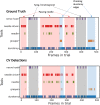Simulated outcomes for durotomy repair in minimally invasive spine surgery
- PMID: 38200013
- PMCID: PMC10781746
- DOI: 10.1038/s41597-023-02744-5
Simulated outcomes for durotomy repair in minimally invasive spine surgery
Abstract
Minimally invasive spine surgery (MISS) is increasingly performed using endoscopic and microscopic visualization, and the captured video can be used for surgical education and development of predictive artificial intelligence (AI) models. Video datasets depicting adverse event management are also valuable, as predictive models not exposed to adverse events may exhibit poor performance when these occur. Given that no dedicated spine surgery video datasets for AI model development are publicly available, we introduce Simulated Outcomes for Durotomy Repair in Minimally Invasive Spine Surgery (SOSpine). A validated MISS cadaveric dural repair simulator was used to educate neurosurgery residents, and surgical microscope video recordings were paired with outcome data. Objects including durotomy, needle, grasper, needle driver, and nerve hook were then annotated. Altogether, SOSpine contains 15,698 frames with 53,238 annotations and associated durotomy repair outcomes. For validation, an AI model was fine-tuned on SOSpine video and detected surgical instruments with a mean average precision of 0.77. In summary, SOSpine depicts spine surgeons managing a common complication, providing opportunities to develop surgical AI models.
© 2024. The Author(s).
Conflict of interest statement
The authors have no personal, financial, or institutional competing interests in any of the drugs, materials, procedures, or devices described in this article.
Figures




Similar articles
-
Simulation of Dural Repair in Minimally Invasive Spine Surgery With the Use of a Perfusion-Based Cadaveric Model.Oper Neurosurg. 2019 Dec 1;17(6):616-621. doi: 10.1093/ons/opz041. Oper Neurosurg. 2019. PMID: 30924502
-
Durotomy- and Irrigation-Related Serious Adverse Events During Spinal Endoscopy: Illustrative Case Series and International Surgeon Survey.Int J Spine Surg. 2023 Jun;17(3):387-398. doi: 10.14444/8454. Epub 2023 Jun 14. Int J Spine Surg. 2023. PMID: 37315993 Free PMC article.
-
Utility of the Simulated Outcomes Following Carotid Artery Laceration Video Data Set for Machine Learning Applications.JAMA Netw Open. 2022 Mar 1;5(3):e223177. doi: 10.1001/jamanetworkopen.2022.3177. JAMA Netw Open. 2022. PMID: 35311962 Free PMC article.
-
Incidental durotomy during spine surgery: incidence, management and complications. A retrospective review.Injury. 2012 Apr;43(4):397-401. doi: 10.1016/j.injury.2010.12.014. Epub 2011 Jan 19. Injury. 2012. PMID: 21251652 Review.
-
AI-powered real-time annotations during urologic surgery: The future of training and quality metrics.Urol Oncol. 2024 Mar;42(3):57-66. doi: 10.1016/j.urolonc.2023.11.002. Epub 2023 Dec 22. Urol Oncol. 2024. PMID: 38142209 Review.
Cited by
-
Artificial Intelligence in Surgery: A Systematic Review of Use and Validation.J Clin Med. 2024 Nov 24;13(23):7108. doi: 10.3390/jcm13237108. J Clin Med. 2024. PMID: 39685566 Free PMC article. Review.
-
Artificial intelligence integration in surgery through hand and instrument tracking: a systematic literature review.Front Surg. 2025 Feb 26;12:1528362. doi: 10.3389/fsurg.2025.1528362. eCollection 2025. Front Surg. 2025. PMID: 40078701 Free PMC article. Review.
References
Publication types
MeSH terms
LinkOut - more resources
Full Text Sources

